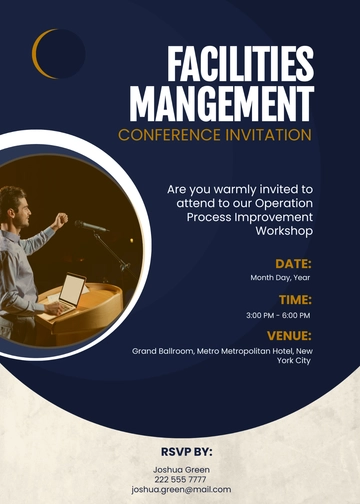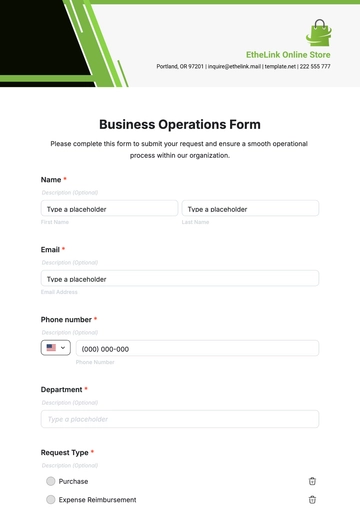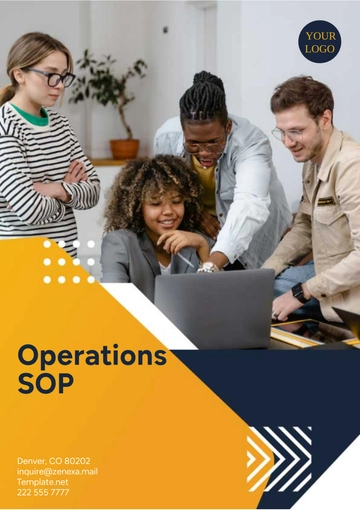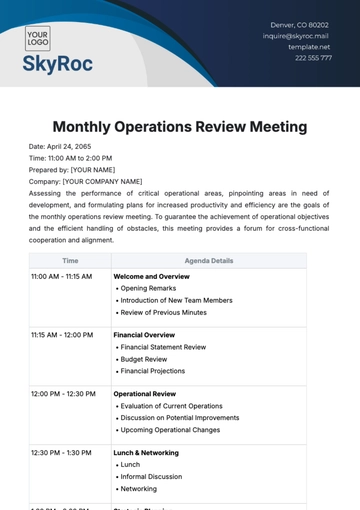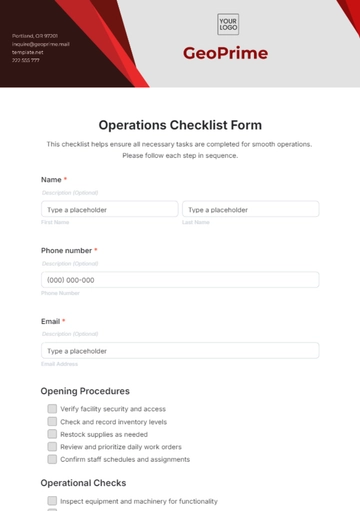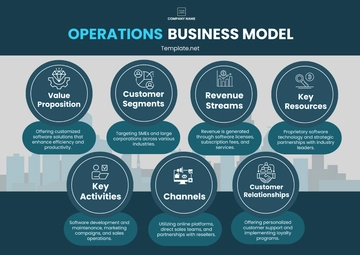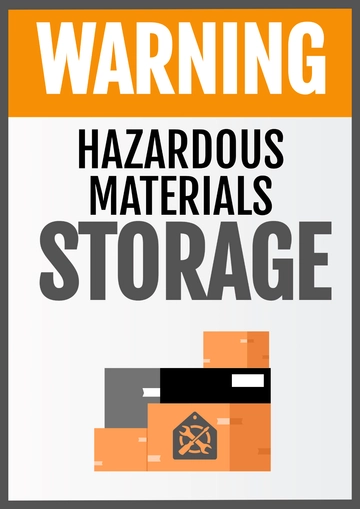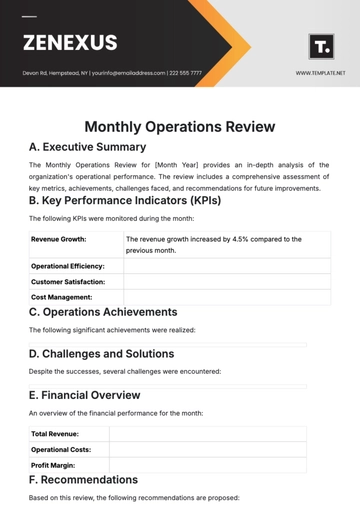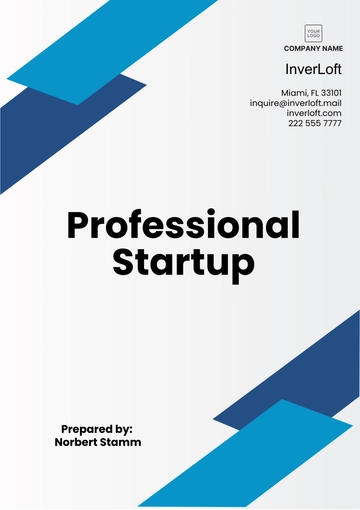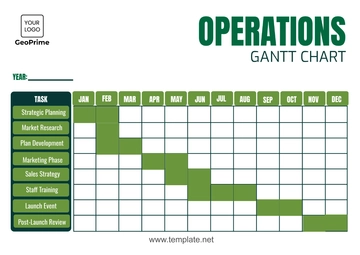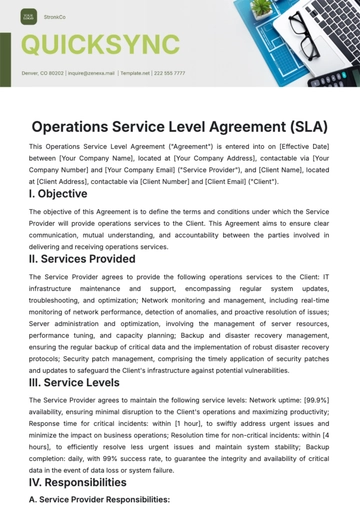Free Operations Project Completion and Handover Protocol
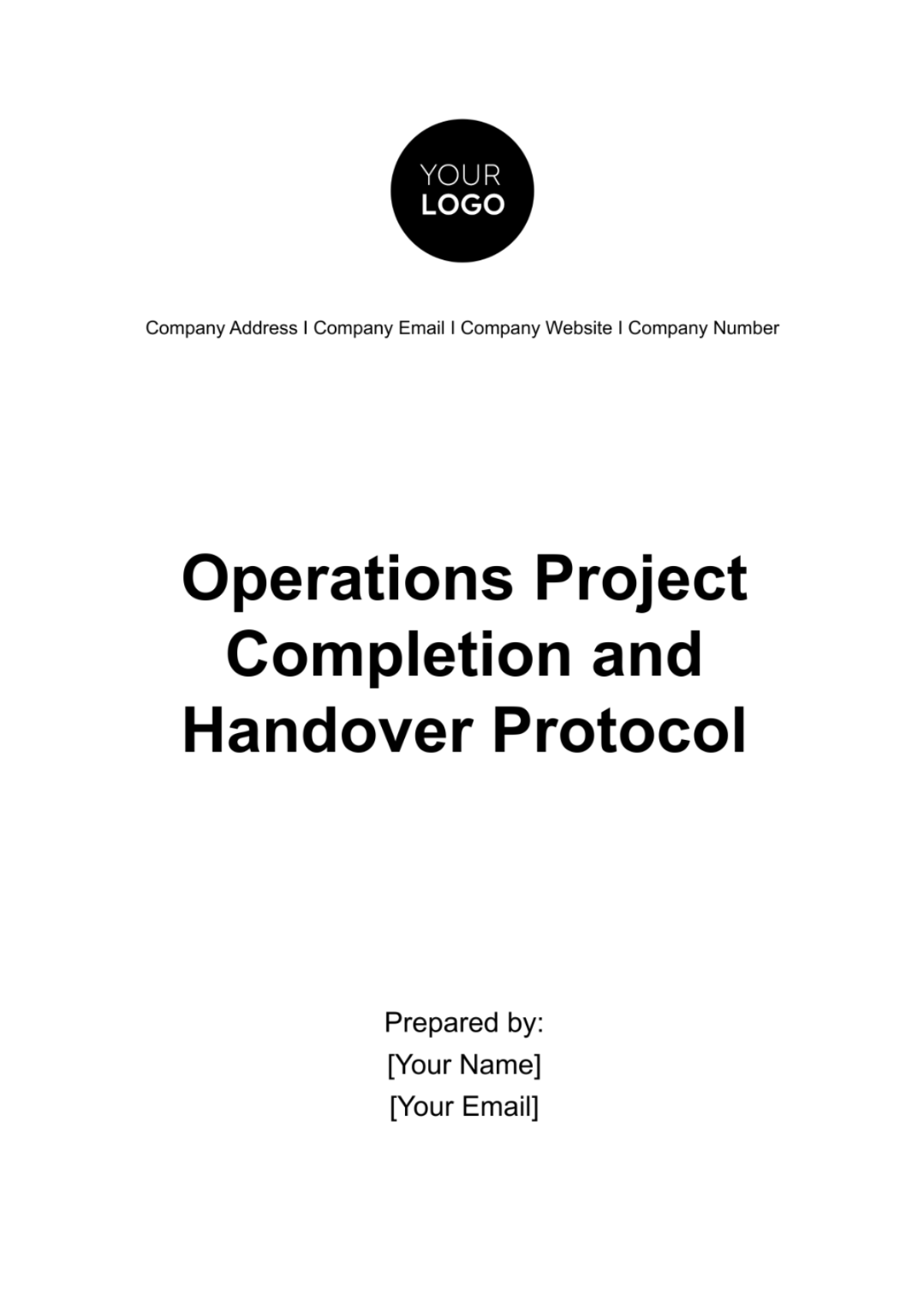
I. Introduction
Purpose of the Protocol
The Operations Project Completion and Handover Protocol serves as a comprehensive guide to facilitate the seamless transition of the [Project Name] from the project team to the operations team. It outlines the procedures, responsibilities, and documentation requirements necessary to ensure that all project deliverables are successfully transferred and integrated into ongoing operations. By establishing clear guidelines, this protocol aims to minimize disruptions, mitigate risks, and maximize the long-term value of the project investment.
Scope and Objectives
This protocol applies to the handover of all project deliverables related to the [Project Name], including building infrastructure, mechanical and electrical systems, and IT infrastructure. The objectives of this protocol are to ensure that all project deliverables meet the required standards and specifications, that operations personnel are adequately trained to operate and maintain the facilities, and that effective communication and coordination are maintained throughout the handover process.
Definitions and Terminology
Project Manager: [Name], responsible for overseeing the construction and implementation of the new office building project.
Operations Manager: [Name], tasked with managing the ongoing operations and maintenance of the new office building.
Stakeholders: Includes representatives from the project team, operations team, client organization, and external contractors involved in the project.
II. Project Overview
Background and Context
The aim of the project, referred to as [Project Name], is to design and construct an cutting-edge office facility that is tailored to suit the escalating requirements of [Your Company Name]. This expansive project encompasses not only the fundamental facets of design and construction but also includes outfitting the building, ensuring it is embedded with contemporary amenities and sustainable features which align with the ethos of modern architecture and environmentally-conscious businesses. The project revolves around the creation of a sizeable, 10-story office building from its initial blueprint stage to its final implementation and operational phase. Each stage of the project has been carefully planned out and can be classified into several key milestones. The commencement of the project will involve preparing the construction site, ensuring it is optimally ready for the building processes that follow.
This will then transition into the laying of the foundation, which forms the elemental base of the structure. Once the foundational structures are securely in place, the next milestone involves the erection of the structural framework according to the specified design. After this comes the interior fit-out stage, during which all interior spaces will be furnished and outfitted with necessary equipment, fixtures, and fittings.
Finally, the project will enter its last stage which is the commissioning phase. During this phase, all systems will be thoroughly tested to confirm they are functioning optimally, and any necessary adjustments will be made. This ensures that the resulting office facility is not only of state-of-the-art quality, but also perfectly suited to the needs and growth trajectory of [Your Company Name].
Project Goals and Objectives
The main focus and priority of the project at hand is to construct an office building of the highest quality that will fulfill the operational demands as well as meet the architectural design specifics dictated by [Your Company Name]. This project must be carried out within the budgetary limits that have been set, and it's crucial not to exceed the predetermined timeline. This project has several objectives. These objectives include the acquisition of Leadership in Energy and Environmental Design (LEED) certification, which exemplifies our commitment to eco-friendly and sustainable building techniques. Additionally, our project aims to strictly comply with all relevant building codes and regulations, in order to ensure the final product is a building that adheres to all applicable legal standards. The final objective of the project is to provide an office building that will serve as a safe and efficient working environment for all individuals who will occupy the space. Safety and operational efficiency will be key considerations in the design and implementation of the project.
Stakeholder Identification
Stakeholder Group | Key Individuals | Job Title |
|---|---|---|
Project Team | [Name] | Project Manager |
Operations Team | [Name] | Operations Manager |
Client Representatives | [Name] | CEO of [Your Company Name] |
III. Documentation Review
This section outlines the process for reviewing and verifying project documentation. Please complete the table below by listing the required documents, their descriptions, responsible parties, and current status (complete/incomplete).
Document Name | Description | Responsible Party | Status (Complete/ Incomplete) |
|---|---|---|---|
Project Plan | Detailed plan outlining project scope, schedule, and resources. | Project Manager | Complete |
Technical Specifications | Detailed specifications for project deliverables. | Technical Team | |
Test Reports | Reports documenting testing activities and results. | QA Team | |
Operation Manuals | Manuals providing guidance on operating and maintaining project deliverables. | Technical Writers |
IV. Verification of Deliverables
In this section, please provide details on the verification process for project deliverables. Complete the table by specifying each deliverable, its acceptance criteria, verification method, and current status (accepted/rejected).
Deliverable Name | Acceptance Criteria | Verification Method | Status (Accepted/Rejected) |
|---|---|---|---|
System Software | Must be compatible with specified hardware and meet performance requirements. | System Testing | Accepted |
Equipment Installation | Must be installed according to manufacturer guidelines and safety regulations. | Inspection | |
Data Migration | Must be completed without data loss or corruption. | Data Validation | |
Training Materials | Must be comprehensive and understandable for end-users. | Review |
V. Testing and Quality Assurance
Testing Plan Overview
The testing plan for the [Project Name] project includes functional, performance, and integration testing of all building systems. It encompasses testing of HVAC systems, electrical systems, fire safety systems, and IT infrastructure to ensure they meet specified requirements. Testing activities will be conducted in accordance with industry standards and best practices to verify the reliability and functionality of the building systems.
Test Cases and Scenarios
To ensure the optimum performance of each building system, we have painstakingly crafted detailed test cases and scenarios. Examples of these scenarios range across all building systems. In relation to the Heating, Ventilation, and Air Conditioning (HVAC) system, the tests include scenarios concerning effective temperature control, methods of monitoring air quality, as well as improvements in energy efficiency. For the electrical system, the developed scenarios encompass tests for power distribution, checking the functionality and control of the lighting system, and in addition, the examination of emergency backup systems. Furthermore, there are test cases and scenarios developed specifically for the fire safety systems. These are aimed at identifying how well smoke is detected, how efficiently alarms are activated in cases of emergency, as well as testing the functionality of the sprinkler system. The purpose of all these is to confirm that each system can react effectively to various challenges, ensuring the building remains safe and efficient.
Quality Assurance Procedures
Quality assurance procedures will be implemented throughout the testing process to ensure that all testing activities are conducted effectively and efficiently. This includes regular review of test plans, execution of test cases by qualified personnel, and documentation of test results. Additionally, quality assurance checks will be performed to verify compliance with project requirements, standards, and specifications.
Documentation of Test Results and Findings
The testing process that is to be undertaken will have its progress and outcomes tracked by means of thorough documentation of the results from each individual test and the details of all the findings from these various tests. This comprehensive documentation will serve as a point of reference for understanding how far we've come in our testing activities and what we have discovered thus far. It is crucial to mention that this process of meticulous documentation won't be strictly limited to just the test results and findings. Indeed, it will extend to incorporating detailed records of each test execution. Every aspect of the test execution will be documented in totality, providing a holistic perspective of how each test was conducted to achieve the said results.
Additionally, this documentation will also provide a comprehensive account of any and all defects or issues that have been identified during the process of testing. It will take note of each and every anomaly, error or problem that has been unearthed by to the testing activities.
In order to ensure transparency in the testing process and to establish accountability, these test reports that contain all these extensive details will be reviewed regularly. Not just by the testing team, but by all stakeholders involved in the project. The aim of this review will be to ensure that everyone is on the same page with regard to the testing process and to align everyone's understanding of the testing journey that has been thus far.
VI. Training and Knowledge Transfer
Training Needs Assessment
A training needs assessment has been conducted to identify the knowledge and skills required by operations personnel to effectively operate and maintain the new office building. This assessment considered the complexity of building systems, technological advancements, and specific job roles within the operations team.
Training Plan and Curriculum
Based on the training needs assessment, a comprehensive training plan and curriculum have been developed to address the identified gaps in knowledge and skills. The training plan includes a combination of classroom training, hands-on workshops, and online learning modules to accommodate different learning styles and preferences.
Training Delivery Methods
Training will be delivered using a variety of methods to ensure accessibility and effectiveness. This includes instructor-led sessions conducted by subject matter experts, practical demonstrations of equipment and systems, and self-paced e-learning modules accessible via the company's learning management system.
Evaluation of Training Effectiveness
In order to evaluate the effectiveness of the training, various strategies will be employed. Before and after the training, assessments will be conducted to gain an understanding of the trainees' improvement and proficiency. More specifically, the trainees will be expected to complete quizzes that test their knowledge and understanding of the material taught during the training program. Additionally, practical demonstrations will serve as a useful tool to practically measure the capabilities and skills that the trainees have garnered from the training. Beyond these objective measures, feedback will be actively solicited from the trainees themselves. Their input will provide valued insights into not only their perspective on the program’s relevance to their roles, but also their evaluation of the clarity of the content delivered. They will also be expected to provide feedback on the usefulness of the training materials, as well as the delivery methods.
This will aid in making informed modifications and improvements, to ensure that the training program remains effective and beneficial for future trainees. Notably, this feedback loop will foster the ever-evolving nature of training programs, making them more flexible and responsive to the specific needs and preferences of the trainees.
VII. Transition Planning
Transition Strategy and Timeline
A detailed transition strategy and timeline have been developed to guide the handover process from the project team to the operations team. The strategy outlines key activities, milestones, and dependencies involved in the transition, while the timeline provides a structured timeline for executing these activities.
Roles and Responsibilities during Transition
Clear roles and responsibilities have been defined for project team members, operations team members, and other stakeholders involved in the transition. This includes assigning specific tasks and deliverables to individuals or teams responsible for executing them and establishing communication channels for coordination and collaboration.
Communication Plan for Stakeholders
A communication plan has been established to keep stakeholders informed and engaged throughout the transition process. This includes regular updates via email, meetings, and progress reports, as well as designated points of contact for addressing questions, concerns, and feedback.
Risk Management during Transition
A risk management plan has been developed to identify potential risks and mitigate their impact on the transition process. This includes proactive measures such as contingency planning, risk assessments, and monitoring of key performance indicators to ensure that the transition stays on track and any issues are addressed promptly.
VIII. Handover Documentation
Operation Manuals and Guides
Comprehensive operation manuals and guides have been prepared to provide detailed instructions for operating and maintaining the new office building. These documents cover topics such as building systems operation, maintenance procedures, troubleshooting guides, and emergency protocols.
Maintenance Schedules and Procedures
Maintenance schedules and procedures have been developed to ensure the ongoing reliability and performance of building systems. This includes regular preventive maintenance tasks such as inspections, lubrication, and filter replacements, as well as corrective maintenance procedures for addressing equipment failures or malfunctions.
Support Contacts and Escalation Procedures
Contact information for technical support and escalation procedures has been provided to facilitate prompt resolution of issues or concerns. This includes contact details for onsite facilities staff, equipment manufacturers, and third-party service providers, as well as procedures for escalating issues to higher levels of management if necessary.
Warranty and Service Level Agreements
Warranty and service level agreements have been documented to outline the terms and conditions of support and maintenance services. This includes coverage periods, response times, and service level targets, as well as procedures for requesting warranty repairs or service under the agreement.
IX. Post-Implementation Review
Review Objectives and Scope
The post-implementation review aims to evaluate the overall success of the project and identify opportunities for improvement. Key objectives include assessing project performance against established goals and objectives, identifying lessons learned, and capturing best practices for future projects.
Data Collection Methods
Data will be collected through a combination of methods, including surveys, interviews, document reviews, and analysis of project metrics and performance indicators. This will allow for a comprehensive assessment of various aspects of the project, including stakeholder satisfaction, project deliverables, and adherence to project timelines and budgets.
Analysis of Lessons Learned
Findings from the post-implementation review will be analyzed to identify lessons learned and areas for improvement. This includes analyzing root causes of issues or challenges encountered during the project, identifying successes and areas of excellence, and synthesizing recommendations for future projects.
Recommendations for Future Projects
Based on the analysis of lessons learned, recommendations will be developed to inform and improve future projects. This may include changes to project management processes, adjustments to project methodologies or tools, and recommendations for enhancing collaboration and communication among project stakeholders.
X. Approval and Sign-off
Review and Approval Process
The review and approval process for the Operations Project Completion and Handover Protocol involves key stakeholders thoroughly assessing the document for accuracy, completeness, and alignment with project objectives. The document will be circulated among the project team, operations team, and client representatives for their review. Feedback and revisions will be incorporated as necessary, ensuring that all parties are in agreement with the outlined procedures.
Sign-off by Key Stakeholders
Once the document has undergone the review and revision process, sign-off will be obtained from key stakeholders to signify their acceptance of the protocol and commitment to its implementation. Signatories will include the Project Manager, Operations Manager, and relevant client representatives. This formal sign-off ensures accountability and serves as official acknowledgment of the successful completion of the project and its transition to operations.
- 100% Customizable, free editor
- Access 1 Million+ Templates, photo’s & graphics
- Download or share as a template
- Click and replace photos, graphics, text, backgrounds
- Resize, crop, AI write & more
- Access advanced editor
Introducing the Operations Project Completion and Handover Protocol Template from Template.net. This editable and customizable template streamlines the transition process with its comprehensive structure. Seamlessly tailor it to your project needs using our AI Editor Tool. Ensure clarity and efficiency in handing over projects with this versatile tool, designed to simplify your workflow and maximize productivity.
